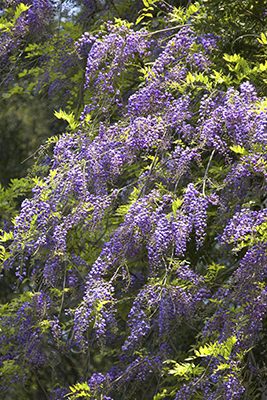 There may be a bit of a lull this month as early summer flowers come to an end and the late season contributors gear up to full speed for a few weeks time. Regular deadheading will extract the maximum performance from all those individuals which produce a succession of blooms and will tidy up those which otherwise hold onto faded flowers. Roses are a case in point; repeat flowerers need to have their deadheads removed to encourage further flushes and single flowering varieties look messy if not cleaned up. The exception being those which bear decorative hips and should therefore be left intact if you are to enjoy their fruit into the winter.
There may be a bit of a lull this month as early summer flowers come to an end and the late season contributors gear up to full speed for a few weeks time. Regular deadheading will extract the maximum performance from all those individuals which produce a succession of blooms and will tidy up those which otherwise hold onto faded flowers. Roses are a case in point; repeat flowerers need to have their deadheads removed to encourage further flushes and single flowering varieties look messy if not cleaned up. The exception being those which bear decorative hips and should therefore be left intact if you are to enjoy their fruit into the winter.
Annual plants in containers, hanging baskets and those used as gap fillers, in flower borders, benefit the most from constant removal of dead flowers as they are programmed to keep blooming as long as they don’t set seed. Watering can be tricky if the weather is hot and you’ve got plans to go away. A friendly neighbour is your best bet although automatic watering systems are much cheaper these days plus emergency plunge pools, augmented by standing in saucers (the pots, not you!), will tide your pot plants over for a week or two.
Feeding is easy if you allow yourself to use any of the proprietary liquid feeds that are on the market. Organic gardeners should avoid the ‘chemical soup’, branded, products and make their own. Unlike off the shelf products you won’t actually know what’s in your homespun concoction so it’s impossible to know whether it’s providing all the ‘NPK’ (nitrogen: phosphate: potassium) and myriad trace elements that your greedy little plants require.
The traditional, home-made, organic liquid feed is based on chopped up comfrey leaves, steeped in water, broken down over time to release a putrid essence which is used, diluted by guesswork, as the basis for a liquid feed. I have seen good results using such naturally occurring feeds although it may take a few trials and errors until you find a mix which works for you. Comfrey is a good groundcover plant for difficult corners of the garden so it’s worth having even if you never experiment with making your own liquid fertiliser.
Last month I suggested cutting hedges as a means of ‘sharpening up’ the garden but this month they really will need doing if not tackled before. Many fast growing species, privet and lonicera being the main culprits, will have required trimming well before now but will probably benefit from another cut soon, or at least before autumn.
It’s traditional to start cutting yew hedges in august, they only require one cut per year, as this makes them nice and tight before the cold weather arrives yet gives any new growth, promoted by the trimming, the chance to toughen up before the winter frosts and snow. If you have a variety of hedge types then start with the faster growing species and leave the yew until last as it is still safe to cut it well into next month.
Don’t leave them all until the last minute (this is a case of “Don’t do as I do, do as I say”!) because if we enter a prolonged period of nasty weather you’ll end up being forced to tackle them, up a ladder, wielding buzzing hedge-trimmers, in a Force 9 gale. If you have a shredder and want to compost the trimmings then it’s worth making sure that you collect them onto a tarpaulin, or old sheet, so that you don’t end up contaminating the green material with soil or stones which could damage the shredder -this I have learned from bitter experience.
Now is a good time to think about what you are going to need in the way of spring flowering bulbs, as the bulb catalogues have already been out for about a month. It’s also the right time to plant autumn flowering bulbs. These can be popped into the ground, or containers, now to give you an almost instant ‘pick me up’. Autumn flowering crocus, colchicums and cyclamen are the usual suspects but more unusual species, such as Sternbergia, are worth seeking out if you want more of a challenge (the latter is said to prefer a “deep, rich, alkaline soil” which might explain why it struggles in my garden).
Something else which may be challenging but which is, ultimately, very rewarding is propagating by means of cuttings. At this time of year shrub growth has had a chance to mature to the ‘semi-ripe’ stage. This means that cuttings made from these shoots are easier to handle and are more able to survive once separated from the parent plant.
Cuttings of pencil thickness, and a generous finger length, have all but their uppermost leaves removed, are inserted into gritty compost around the edge of a pot; watered in; covered with a plastic bag (supported on a cane and tied around the edge) and left somewhere light but not baking until they either root or die. This may take a couple of weeks, or a couple of months, depending on the species. Try anything that has suitable shoots as plants don’t tend to read propagating manuals so don’t know if, or when, they are supposed to root from semi-ripe cuttings; many of the early summer flowering shrubs are worth a try.
That should give you a few things to be getting on with. If you really do have time on your hands, and are lucky enough to own a mature wisteria, then August is the oft quoted month in which to shorten its tangled extension growth. It gets a more drastic prune in late winter so it’s not the end of the world if you don’t get around to it now—although it might peel itself off the wall in a high wind. We’ve had a pretty even-handed year so far, weather wise, but don’t get too complacent. Summer storms can come with gusty winds and sudden downpours so it’s always worth checking that plants are well supported and tied in wherever necessary—sorry to end on a downer—happy gardening!








